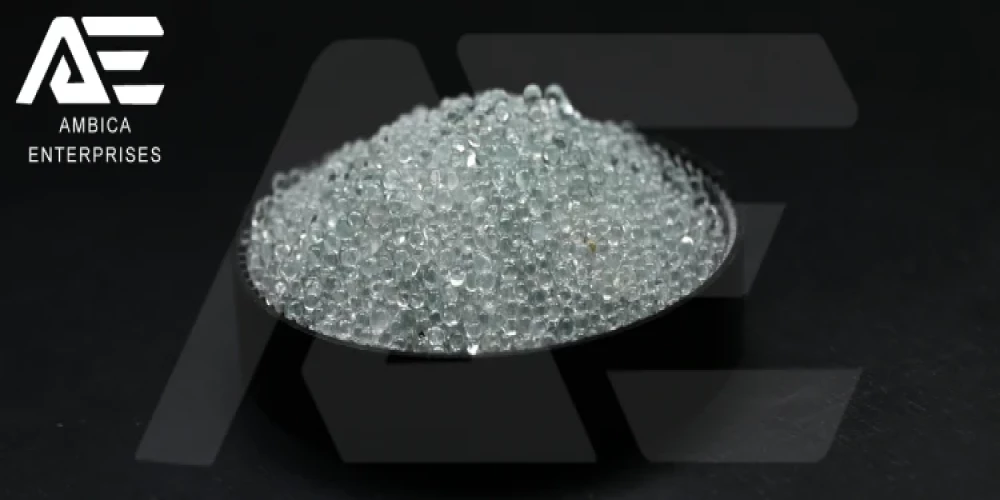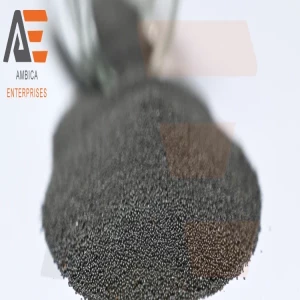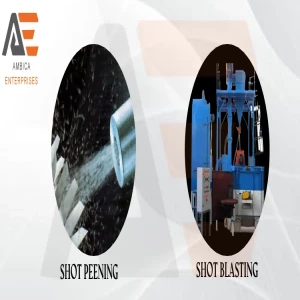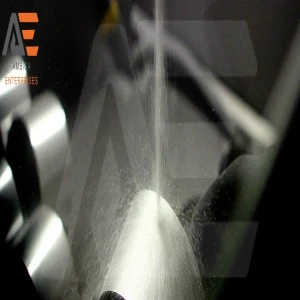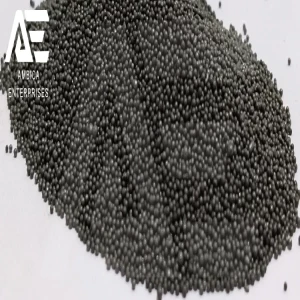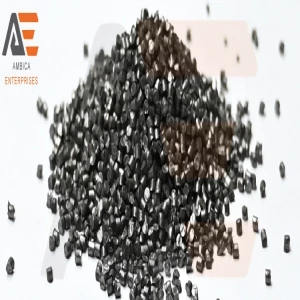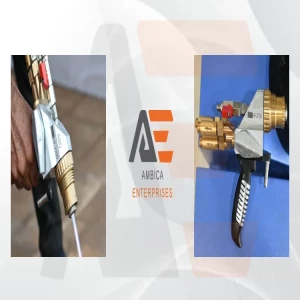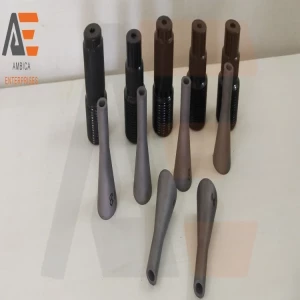A clean, shiny, peened, satin finish is produced by glass bead abrasive blasting without the parts' dimensions changing. About 30 times can be recycled from them. Glass bead are a suitable way of metal cleaning or surface finishing when properly managed because they are chemically inert and environmentally safe.
Glass bead abrasives are typically used in blasting cabinets for honing, polishing, peening, blending, finishing, eliminating light burrs, and cleaning the majority of light foreign matter. They are readily available in a variety of sizes. Peening with glass bead abrasive material offers the ideal amount of stress relief for delicate thin-walled items and thin welds without over-stressing and risking damage.
Glass bead are available in many sizes, ranging from tiny seed bead to bigger bead that can be used as focal points in jewellery designs. Second, think about the bead's shade and level of polish. Consider the overall colour scheme of your creation when selecting bead, and select bead that contrast or complement your other materials. Lastly, take into account the bead's shape. Round, oval, teardrop, and other shapes are just a few of the many shapes available for glass bead.
What is Glass Bead Method
A popular and efficient method for cleaning and preparing metal surfaces for painting or other coatings is the glass bead method. This method creates a structured surface that enhances good compatibility and just doesn't destroy the base metal by blasting dirt away with small glass beads. The glass bead approach is a secure, cost-efficient, and ecologically responsible choice for many applications, while it might not be appropriate for all kinds of metal surfaces.
It's important to keep in mind that not all metal surfaces can be treated with the glass bead approach. For surfaces that are highly polished or have a thin coating, for instance, it might not be suitable since the glass bead could scratch or destroy the surface. Also, it is necessary to use this procedure with the proper safety precautions because the tiny glass bead can be dangerous when they are inhaled or come into contact with the skin or eyes.
Using compressed air, the glass bead are blasted into the metal surface at a high rate of speed in the glass bead process. The impurities are broken up and lifted away from the metal as a result of the Glass bead collision, which causes minute craters and cracks in the surface. Moreover, the metal's surface is given a fine texture during this process, which enhances paint or other coatings' application.
How are Glass Bead Used in Road Marking ?
Glass bead have an important function in their use in road marking, By enhancing the visibility and reflectivity of road markings. Glass bead marks are more visible thanks to their reflective qualities, which is important for road safety, particularly at night and in poor light. We can prevent accidents and improve everyone's safety on the road by adding glass bead into the materials used for road marking.
glass bead are added to the road marking materials, To increase the reflectivity of the marks. Glass bead are added to the road marking materials. The application of paint or thermoplastic for use as road markings is followed by the coating of glass beads while the material is still wet. The glass bead becomes enmeshed in the material when it dries, producing a reflecting surface that aids in making the markings more visible.
Advantages of Glass Bead Road Marking
- Glass bead reflecting characteristics make road markers easier to see, especially at night and in low light.
- Glass bead are a useful tool for enhancing road marking readability, which can assist decrease accidents and improve traffic safety.
- Glass bead are extremely robust and can survive the scratch caused by crowded roads and inclement weather.
- The transparency and safety of roadways can be increased at a reasonable cost by using glass bead as road markings.
- Glass Bead High Reflective Performance
glass bead exhibit a high level of reflective performance, Due to its resilience, spherical shape, size, and refractive index. They are a key component of retroreflective sheeting, clothing, and road markings, which create a safer environment for drivers and other road users in low light or at night. They offer a high level of reflective performance when used appropriately, which is essential for safety in low light or at night.
A cutting-edge technology called glass bead with outstanding reflecting performance has revolutionised the way we see traffic safety. Tiny glass bead are applied to road surfaces, signs, and other objects using glass bead reflecting technology to improve visibility and reflectivity. A combination of the reflecting qualities of glass and the utilisation of cutting-edge production techniques results in the high reflective performance of glass bead technology.
Glass bead ability to reflect light has long been understood. Since glass is naturally reflective, it has been utilised for a variety of purposes, including mirrors and lenses. The earliest applications of glass bead technology for enhancing road safety, however, did not appear until the 1930s. To enhance visibility during the time, tiny glass bead were added to paint and painted onto the surfaces of roads to help with vision at night and in low light.
Glass bead technology has developed into a very complex procedure. Modern manufacturing processes are employed to create uniformly sized and shaped, high-quality glass bead. To ensure optimal reflectivity, these glass beads are subsequently placed with specialist machinery to road surfaces and other materials.
Glass bead technology has a high level of reflectivity. Glass bead are very visible in all lighting conditions because they reflect light back to its source. They are therefore perfect for usage on road surfaces, where they increase visibility and lower the possibility of accidents.
The glass bead technique is also very long-lasting and robust. Because the small glass bead are enmeshed in the surface material, they are immune to damage and injury. They are therefore perfect for usage in noisy areas where they are subjected to constant use and extreme weather.
How do Polish aluminum after bead blasting ?
With the appropriate equipment and methods, polishing aluminium after bead blasting can be achieved easily. Aluminum parts are frequently treated with glass bead blasting to remove impurities and produce a uniform surface polish. Yet, the aluminium surface may appear ugly and dull after bead blasting. Aluminum must be polished in order to regain its brilliance and brightness. We'll talk about aluminium polishing .
1. Clean the Surface -
It's necessary to thoroughly clean the aluminium surface before you start the polishing procedure. During the polishing process, any remaining bead blasting media or debris may scrape or harm the surface. After removing any loose debris with a soft cloth or brush, wash the region using water and soap to just get rid of any dirt or dust that may have remained.
2. Choose the Appropriate Polish -
The degree of the surface damage and the desired level of shine will determine the type of polish you use. You can use a fine-grit polishing product to repair minor surface damage. You might need to use a coarse-grit compound first, then a fine-grit compound, for more severe damage or deeper scratches.
3. Put the polish on -
A clean fabric or buffing wheel should be coated with a little amount of polish. Working with tiny portions at a time, start by rubbing the polish into the surface in a circular motion. Use gentle pressure, being mindful not to burn the surface by pressing too quickly or aggressively.
4. Surface Buffing -
When the polish has been applied, polish the surface in a circular path using a clean, soft cloth or buffing pad. Boosting should continue until the surface has a consistent sheen. Use mild, even pressure, being careful not to overheat the surface.
5. Clear the Space -
While you're done polishing, clean the surface with a soft, clean cloth or towel. Check the surface for any scratches or remaining debris. Repeat the polishing operation as necessary until the surface is consistently polished.
5. Glass Bead Blasting vs Aluminum Oxide
It's essential to keep your application's particular requirements into account when choosing between aluminium oxide and glass bead blasting. Glass bead blasting might be a preferable choice if you're working with sensitive materials or need a smooth, consistent surface finish. Aluminum oxide blasting might be the preferable option if you are working with heavy surface impurities or need a rough surface finish for better adhesion. The best way to select the optimal technique for your application is to speak with a seasoned surface preparation business. They can help you assess your needs and make recommendations for the most suitable approach.
Glass Bead Blasting -
Glass bead blasting is frequently employed to eliminate surface impurities including rust, paint, and scale and to produce a consistent surface finish. It is frequently employed in sectors including manufacturing, aerospace, and the automobile industry. Small, round bead are used in glass bead blasting, a type of abrasive blasting, to clean and prepare surfaces. Using an air compressor, the glass bead are launched onto the surface being treated at a high rate of speed.
Glass bead blasting additionally results in a smooth, satin-like finish, which is perfect for surfaces that demand a high degree of visual impact. It is a wonderful option for delicate or complicated areas because of this. It is not recommended to use it on hard materials like steel because it is ineffective at removing significant corrosion or coatings. Glass bead blasting does have the benefit of being quite gentle and not affecting the surface being treated.
Aluminum Oxide Blasting -
Aluminum oxide blasting is frequently used to clean surfaces of severe corrosion, coatings, and rust as well as to roughen the surface to improve the adhesion of paints and coatings. Aluminum oxide is used in aluminium oxide blasting, also referred to as sandblasting, to clean and prepare surfaces. It is a form of abrasive blasting similar to glass bead blasting in that the particles are propelled onto the surface by compressed air. Construction, shipping, and industrial maintenance are among the industries that frequently used it.
Aluminum oxide blasting, on the other hand, can be more aggressive and may harm delicate or thin materials. Aluminum oxide blasting really does have the benefit of being extremely efficient at removing stubborn surface impurities from a variety of materials, including steel, concrete, and stone. It also produces a rough surface finish that is perfect for coating or painting applications that demand a high degree of retention.
6. Glass Bead Blasting Cabinet
Glass bead blasting cabinets come in two varieties: suction and pressure. The glass bead blasting process is made possible by a machine called a glass bead blasting cabinet. The cabinet, which is frequently built of metal, has a window that allows users to observe the blasting process inside a sealed interior chamber.
The air cannon is used in a suction glass bead blasting cabinet to draw the glass beads through a tube and out of a nozzle. Because it offers a lesser degree of blasting pressure, this type of cabinet is often utilised for smaller parts.
The glass bead are forced out of the nozzle by compressed air in a pressure glass bead blasting cabinet. This kind of cabinet is stronger and frequently utilised for larger parts or parts that call for more forceful cleaning or texturing.
How Does A Glass Bead Cabinet Work?
The impact of the glass bead on the surface helps clean it of grime, rust, and other impurities while also imparting a textured finish. Little glass bead are blasted onto the surface of the item being cleaned or textured at a high rate of speed during the glass bead blasting process.
The operator can watch the blasting process through the window in the interior chamber of the cabinet, which is sealed to keep the glass bead inside from escaping. This process is possible in a controlled atmosphere attributable to the glass bead blasting cabinet.
To protect against the glass bead and dust, the operator dons protective clothes such as knee pads, sunglasses, and a breather. A suction or pressure mechanism is used to spray the glass bead onto the surface of the component once it has been placed within the cabinet.
Features of a Glass Bead Blasting Cabinet?
Glass bead blasting is a quick and effective procedure that makes it possible to clean or texture significant numbers of items quickly.
Steel, silicone, and plastic are just a few of the materials that can be blasted with glass bead.
Glass bead blasting is a very accurate procedure that produces complex patterns and textures.
Glass bead blasting is a more environmentally friendly solution than other surface finishing techniques because glass bead are non-toxic and recyclable.
7. Glass Bead Making
Making glass bead is still mostly an artistic approach, but it has also developed into an industrial operation. To meet the increasing demand for their use in a variety of applications, glass bead are now produced on a global level. Making glass bead is utilised in the business for many different things, including as reflective coatings, road markings, and decorative uses.
Industry glass bead production requires advanced tools and qualified personnel. In order to generate the appropriate bead, glass beads are often melted at high temperatures, shaped, and then cooled. Following sorting and packaging, the glass bead are prepared for usage in various applications. In massive production facilities, the procedure is fully automated, and trimming technology and machinery are used to guarantee constant quality and output.
Making glass bead has evolved greatly from its modest beginnings as an art form to become a vital component of numerous industrial uses. In addition to their ornamental uses, glass bead are employed for their reflecting and non-skid properties. While maintaining the beauty and creativity of the skill, the industry has made great changes to the method of making glass beads, making it more effective and scalable.
Glass bead are frequently employed to produce complicated patterns and designs, giving the finished product texture and dimension. glass bead are applied in road markings to create a surface that won't spin. The glass bead are incorporated into the paint or other material used to mark out the roads, improving the surface's traction and lowering the likelihood of accidents. A more conspicuous and robust marker that can resist high traffic and poor weather is also made using the glass bead. Glass bead are used for a wide range of decorative purposes. They are utilised in the creation of metal, as well as in residential and providing features and textiles. The glass bead numerous shades and sizes give designers a wide range of design possibilities.
8. How To Make Lampwork Glass Bead
Great glass bead can be made using the demanding and rewarding method of lampworking. You may produce a wide variety of unique designs and styles with procedure and creativity. A remarkable method for making complex and distinctive glass bead is lampworking. It entails melting glass rods in a torch flame and using a range of instruments to shape the molten glass into attractive shapes. Do the following actions to learn how to create lampwork glass bead -
A torch, glass rods, mandrels, bead release, and various cutting and shaping tools are required.
Pinpoint a place with a strong table or desk that is well-ventilated. Put your torch, equipment, and supplies in a convenient location.
Rollers are small metal rods used to hold beads as you work on them. Bead release, a unique material that keeps the glass from clinging to the metal, should be applied to the end of each mandrel. Before continuing, let the bead release entirely dry.
To determine the right flame temperature for your glass rods, refer to the manufacturer's instructions as different varieties of glassware require different flame temperatures.
When a glass rod's end begins to melt, hold it with one end in the flame of the torch. To ensure equal heating, rotate the rod slowly. The glass can be shaped with your tools once it is melted.
Shape your glass bead with a number of tools, including brushes, marvering pads, and graphite shaping tools. Try out various approaches to produce original designs.
By melting small pieces of coloured glass bead onto the surface or by using a stringer, a thin glass rod used to draw lines and patterns, you can add more colours or patterns to your glass bead.
To keep glass bead from breaking or cracking after you've finished manufacturing them, anneal them. Put the glass bead in a firing with a refractor and gradually increase the temperature until it reaches 950 degrees Fahrenheit. Let the glass bead to gently cool down in the drying chamber for several hours.
9. Are Glass Bead Made of Glass ?
Glass really is used to make glass bead. Glass rods or tubes are heated to a high temperature and then formed into tiny spheres during the melting process to create glass beads. The finished bead are then separated and given various coatings to get the finish or colour that is required. Glass bead are used to make glass bead. Glass is formed into small bubbles and heated to a high temperature during production. These adaptable beads come in a variety of sizes, shades, and finishes and are utilised in a variety of applications. Glass bead are a common choice for adding texture, colour, and shine to your items, whether you're a jewellery maker or an industrial manufacturer.
Dependig on how the glass bead are going to be employed, different types of glass can be used to produce them. For instance, leaded glass, which is softer and simpler to shape than other forms of glass, is frequently used to make beads for accessories. In regards, industrial glass bead are often created from soda-lime glass, which is stronger and more resistant to shattering.
The production of glass bead takes place over the course of various processes. The glass is first melted in a furnace at 1700–2100°F temperatures. A device known as a bead-making machine is used to shape the glass into a small spherical shape after it has been melted. After cooling, the beads are separated by size and quality.
To improve their appearance or qualities, the glass bead may be given different coatings or finishes after sorting. A metallic finish may be applied to some beads to make them shine, while an exotic finish may be applied to others to give them a turquoise aspect.
10. Facts for Better Glass Bead
They are constructed from a range of glass materials, including soda-lime, borosilicate, and lead glass, and come in a variety of sizes, shapes, and colours. The following information should be taken into account while choosing glass beads for your task. Choosing glass bead can offer a number of advantages, such as a consistent result, environmental friendliness, and financial savings. To get better results, it's crucial to take into account the size, shape, glass type, and safety precautions when selecting and using glass bead.
1. Size Matters
The size of glass bead ranges from tiny powder to giant bead. The impact force and amount of surface polish that can be obtained depend on the size of the glass bead. For delicate cleaning and finishing, for instance, small glass beads work best, whereas larger beads work best for peening and heavy-duty blasting.
2. Many Forms, Several Effects
glass bead can be found in a variety of shapes, including spherical, cylindrical, and irregular. The level of peening that can be achieved and the surface finish of the bead can both be influenced by its form. While irregular beads can offer a more forceful peening action, spherical glass bead are typically more uniform and offer a consistent finish.
3. Glass Type
The characteristics of the glass bead, such as their hardness, chemical resistance, and thermal properties, can also be influenced by the type of glass used to produce them. For example, lead glass bead are less abrasive and denser than soda-lime beads, making them perfect for delicate finishing.
4. Reusing and recycling
Glass bead are an environmentally beneficial choice for surface preparation and finishing since they can be recycled and used again. You may reduce trash and spend less money by recycling glass bead.
5. Protection Initially
Glass bead can release dust contaminants that are hazardous to breathe in. When working with glass beads, it's crucial to wear safety equipment such as a respirator, safety glasses, and gloves. While handling and discarding used bead, it's imperative to observe to safety precautions.

